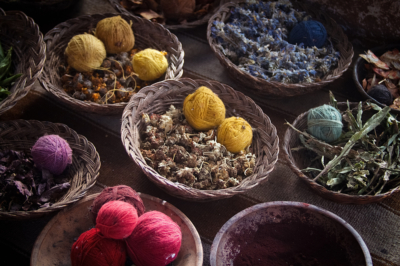You can give natural fabrics bright colors with plants. In the wake of sustainably and ecologically produced textiles, plant dyes are once again gaining in importance. Maybe you feel like bathing the wool for your winter hat or the silk fabric for your next sewing project in a homemade dye liquor and dyeing it in your favorite shade.

What plants are suitable for dyeing
Dyeing plants contain dyes that combine stably with the fibers, making them resistant to washing and light. Among the best known is probably indigo, which gave jeans their typical blue hue until about 1900.
There are about 150 dye plants worldwide, some of which are still cultivated commercially today. The following is a list of the most common indigenous plants:
| Plant name | Characteristics | Achieved hue |
|---|---|---|
| Birch | Pioneer tree with characteristic white bark. The dye is in the leaves. | Bright yellow. By addition of ferrous sulfate further development to olive green. |
| Nettle | Valuable food for insects and healthy wild vegetables. | Bright yellow |
| Oak | Very commonly used tanning drug. The bark is used. | Brown |
| Safflower | Annual flowering plant with conspicuous spines. Used are the petals. | Red orange, golden yellow, brownish yellow. |
| Dyer’s broom | Butterfly plant that used to be cultivated specifically as a dyeing plant. | Yellow |
| Woad | Used to be grown on a large scale. Alternative to indigo. Addition of washing soda required for a durable color result. | Turquoise, blue |
| Madder | Is cultivated specifically as a dyeing plant. Dyeing is done with the crushed roots. | Brick red, rust red, rust brown |
| Delphinium | Popular flowering perennial in the cottage garden. Used are the flowers. | Lime green, green yellow |
| Hollyhock, black | Herbaceous mallow plant. Grows one to two meters high and is a valued ornamental plant. The flowers are used. | Silver gray, green gray |
| Walnut | No pickling is required. The soft shells that sit above the nut are used. | Dark brown, copper brown, beige brown |
| Onion | Important vegetable and spice plant. For dyeing the shells are used. | Copper, yellow |
Dyeing with woad is particularly interesting, as the inlaid fabrics initially turn yellow-brown. Only through contact with oxygen can you “experience your blue miracle”. The fabrics change their tone through the interaction of air and light to medium blue.
How To Use Plants To Dye
- In order for the plant dyes to adhere permanently to the fabrics, they must be stained with alum and/or tartar.
- Bind the plants in a dye cloth and boil them.
- Then place the dyeing material and boil it for one to two hours in the dye liquor.
- Important for wool: do not stir, so that the material does not felt.
- Get the material out of the brew and hang it in the air to dry.
- In the last step, acid (vinegar essence) will fix the colors.
Tips
You can collect dye plants in the wild or grow them specifically in your garden. Most of these plants are undemanding and thrive in almost any soil. Exotic dye plants such as redwood, cochineal or indigo can be obtained from specialist dealers.

